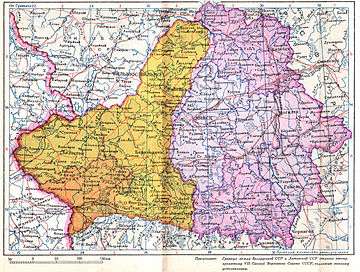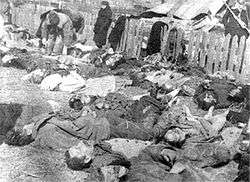Massacre of Brzostowica Mała
 Location of Brzostowica Mała (Малая Бераставіца in belarusian) on the Soviet map of Polish territories (yellow) incorporated into the Soviet Belarus (pink) after the 1939 invasion of Poland |
The massacre of Brzostowica Mała occurred on September 18, 1939 at the onset of World War II in the eastern part of the Second Polish Republic. It was a mass murder of the Polish inhabitants of Brzostowica Mała (Belarusian: Malaya Berestovitsa) committed on the second day of the Soviet invasion of Poland.[1] The massacre was one of a number of similar killings of ethnic Poles in many neighbouring settlements.[2] The perpetrators armed by the Soviets with assault rifles and a machine gun (but also with axes and home-made weapons),[3] were led by the delegalized Communist Party of West Belarus. The fifth column consisted of local Jews and ethnic Belarusians who launched an anti-Polish sabotage action known as the Skidel revolt on the same day in order to assist the external attack.[4] Scores of intoxicated peasants and criminal opportunists have joined the fray.[5]
After the end of World War II and the annexation of eastern Poland by the Soviet Union the massacre was hushed up. The Skidal sabotage action (now Skidzyel’, Belarus) was turned by Soviet propaganda into a liberation movement, and mythologized.[2]
History
The event, described in an exposé by one of the biggest national dailies Nasz Dziennik, has been investigated by the Polish Institute of National Remembrance in 2001–2005.[4] The Institute has determined that the massacre did indeed occur and fell within Poland's communist crime jurisdiction, but because all 16 witnesses cross-checked by the IPN were only second-hand, most of the details cannot be confirmed with full certainty.[4][6][7] Due to the passing of time, the only surviving eyewitness still alive in 2003 was five years old during the massacre.[3]
The witnesses interviewed by the newspaper and later by the Institute, claimed that several dozen Poles (by 2003 IPN has confirmed 7 deaths by name) were massacred on that day,[8] possibly around 50.[3] Among those killed were local officials (including teachers and post office personnel), as well as the members of the szlachta family of Wołkowicki, including Count Antoni Wołkowicki, his wife and his mother buried alive.[2][7] The IPN described the murders as having been carried out by village dwellers mostly from Padbahoniki.[3] The pro-Communist squads organized around the anti-Polish Skidal revolt welcomed the Soviet invasion of Poland which had taken place a day before.[7][8][9] Tens if not hundreds of such incidents took place around Grodno county, wrote IPN historian Marek Wierzbicki.[2]
See also
Sources
- ↑ Marek Wierzbicki (2007). Western Belarus in September 1939 – Polish-Jewish Relations in the kresy. Shared History, Divided Memory: Jews and Others in Soviet-occupied Poland, 1939-1941 by Elazar Barkan, Elizabeth A. Cole, Kai Struve. Leipziger Universitätsverlag. pp. 139–140. ISBN 3865832407. Retrieved January 31, 2014.
- 1 2 3 4 Marek Wierzbicki (1997). "Powstanie skidelskie 1939". Białystok: Białoruskie Zeszyty Historyczne, nr 7. Archived from the original (stored by the Internet Archive) on July 16, 2011. Retrieved December 13, 2012.
- 1 2 3 4 Wojciech Wybranowski (2002-10-02). "Kłopotliwe śledztwo. Dochodzenie w sprawie mordu na Polakach w Brzostowicy Małej utknęło w martwym punkcie" (in Polish). Nasz Dziennik. Retrieved 31 January 2014.
- 1 2 3 Instytut Pamięci Narodowej, PRZEGLĄD MEDIÓW 24 February 2005. Paragraph 28. Decision of the public prosecutor Dariusz Olszewski from the IPN branch in Białymstok. (Polish)
- ↑ Marek Wierzbicki (5/2014 (1613)). "Czystki kresowe" [Soviet purges in the Polish Kresy region]. Tygodnik Wprost. pp. 1, 2, 3. Retrieved 1 February 2014. Check date values in:
|date=(help) - ↑ PRZEGLĄD MEDIÓW - 22-24 September 2003. "IPN nie znalazł zabójców hrabiny Ludwiki Wołkowickiej." (Polish)
- 1 2 3 Informacja o działalności Instytutu Pamięci Narodowej–Komisji Ścigania Zbrodni przeciwko Narodowi Polskiemu w okresie 1 lipca 2002r. – 30 czerwca 2003r. Warszawa, listopad 2003. sygn. akt S 50/01/Zk p.52. (Polish)
- 1 2 Śledztwo IPN w sprawie zbrodni komunistycznej w Brzostowicy Gazeta.pl, 2001-10-04. (Polish)
- ↑ Marek Wierzbicki, Czystki kresowe, Wprost, 38/2002 (1034). (Polish)
